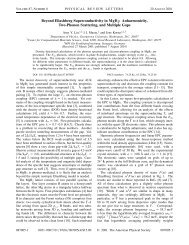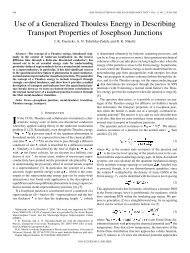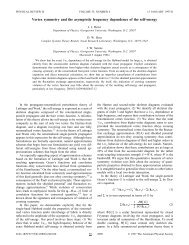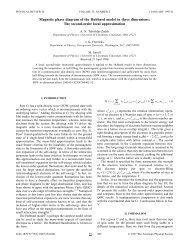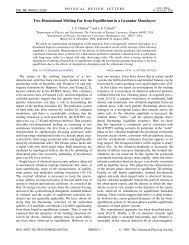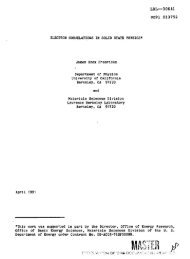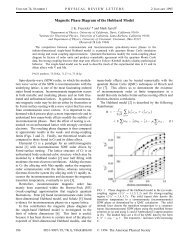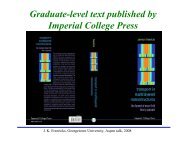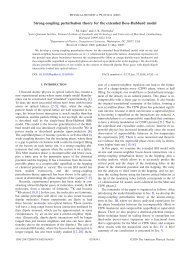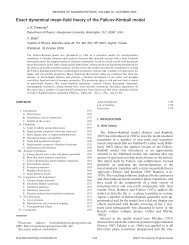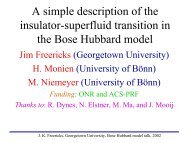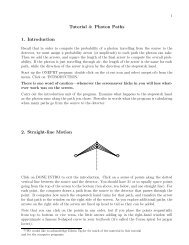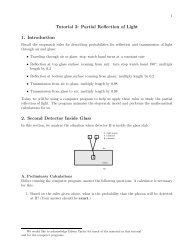Impurity problems for steady-state nonequilibrium dynamical mean ...
Impurity problems for steady-state nonequilibrium dynamical mean ...
Impurity problems for steady-state nonequilibrium dynamical mean ...
Create successful ePaper yourself
Turn your PDF publications into a flip-book with our unique Google optimized e-Paper software.
ARTICLE IN PRESS<br />
Physica E 42 (2010) 520–524<br />
Contents lists available at ScienceDirect<br />
Physica E<br />
journal homepage: www.elsevier.com/locate/physe<br />
<strong>Impurity</strong> <strong>problems</strong> <strong>for</strong> <strong>steady</strong>-<strong>state</strong> <strong>nonequilibrium</strong> <strong>dynamical</strong><br />
<strong>mean</strong>-field theory<br />
J.K. Freericks<br />
Department of Physics, Georgetown University, Washington, DC 20057, USA<br />
article info<br />
Available online 24 June 2009<br />
Keywords:<br />
Nonequilibrium many-body physics<br />
Dynamical <strong>mean</strong>-field theory<br />
Steady <strong>state</strong><br />
Functional methods<br />
abstract<br />
The mapping of <strong>steady</strong>-<strong>state</strong> <strong>nonequilibrium</strong> <strong>dynamical</strong> <strong>mean</strong>-field theory from the lattice to the<br />
impurity is described in detail. Our focus is on the case with current flow under a constant dc electric<br />
field of arbitrary magnitude. In addition to <strong>for</strong>mulating the problem via path integrals and functional<br />
derivatives, we also describe the distribution-function dependence of the retarded and advanced<br />
Green’s functions. Our <strong>for</strong>mal developments are exact <strong>for</strong> the Falicov–Kimball model. We also show how<br />
these <strong>for</strong>mal developments are modified <strong>for</strong> more complicated models (like the Hubbard model).<br />
& 2009 Elsevier B.V. All rights reserved.<br />
1. Introduction<br />
Dynamical <strong>mean</strong>-field theory (DMFT) began in 1989, when<br />
Metzner and Vollhardt suggested the large-dimensional limit<br />
(with an appropriate rescaling of the hopping integral) as a<br />
simplifying limit <strong>for</strong> the many-body problem that nevertheless<br />
still included the important competition between minimizing the<br />
kinetic and potential energies of the system [1]. These ideas were<br />
implemented into a complete DMFT by Brandt and Mielsch with<br />
the exact solution of the Falicov–Kimball model at half filling [2].<br />
Since that time, nearly all equilibrium many-body models have<br />
been solved in the large-dimensional limit with DMFT. Recently,<br />
progress has been made on <strong>nonequilibrium</strong> extensions of DMFT<br />
[3–7] <strong>for</strong> the Falicov–Kimball model and <strong>for</strong> the Hubbard model<br />
[8]. In situations where the perturbing fields (or the timedependent<br />
part of the Hamiltonian) maintains the translational<br />
invariance of the lattice, the self-energy remains uni<strong>for</strong>m and<br />
local, as follows from the Langreth rules [9] and the perturbative<br />
expansion in the hopping by Metzner [10].<br />
In this work, we examine the <strong>steady</strong>-<strong>state</strong> limit of <strong>nonequilibrium</strong><br />
DMFT. We start the system in equilibrium at an inverse<br />
temperature b and wait a long time after the field or timedependence<br />
has been turned on, so that the system has<br />
reorganized itself to the long-time response of the driving fields<br />
(or time dependence) [11,12]. We are inherently assuming that the<br />
long-time limit of the Hamiltonian is different from the original<br />
equilibrium Hamiltonian. It need not have any explicit time<br />
dependence in this limit though. We will show that the Keldysh<br />
<strong>for</strong>mulation of the many-body theory [ignoring the third<br />
(imaginary) branch of the contour described by Wagner [13]]<br />
E-mail address: freericks@physics.georgetown.edu<br />
produces the exact <strong>steady</strong>-<strong>state</strong> solution <strong>for</strong> the Falicov–Kimball<br />
model; we will also discuss modifications <strong>for</strong> the Hubbard model<br />
(and more complicated models). Our approach works with<br />
functional integrals and derivatives. Most of the techniques are<br />
completely straight<strong>for</strong>ward, but these details have not appeared<br />
in the literature yet, and provide useful insights into the solution<br />
of <strong>nonequilibrium</strong> <strong>problems</strong> via DMFT.<br />
2. Formalism <strong>for</strong> the Falicov–Kimball model<br />
We will focus our ef<strong>for</strong>ts first on the Falicov–Kimball<br />
model, whose Hamiltonian [15] is the following (in a uni<strong>for</strong>m<br />
electric field described by a uni<strong>for</strong>m vector potential E ¼<br />
@AðtÞ=c@t):<br />
H FK ¼ X k<br />
fe½k eAðtÞ=‘ cŠ mgc y k c k þ U X i<br />
c y i c iw i ;<br />
where we employed Peierls’ substitution [14]. Here, c k<br />
and c y k<br />
destroy and create a<br />
p<br />
spinless itinerant fermion with momentum k,<br />
eðkÞ ¼ lim d-1 ðt = ffiffiffi P<br />
d Þ d<br />
i¼1 cosk i is the bandstructure on an<br />
infinite-dimensional hypercubic lattice, m is the itinerant-electron<br />
chemical potential, U is the conduction-electron–local-electron<br />
interaction, w i is the number operator <strong>for</strong> the spinless localized<br />
electrons at site i, and we use the real-space basis <strong>for</strong> the itinerant<br />
electron operators in the second term of H. In the following we<br />
set ‘ ¼ c ¼ t ¼ 1.<br />
We are interested in the <strong>steady</strong>-<strong>state</strong> limit of the response,<br />
which can be determined in the limit where the vector potential is<br />
turned on in the infinite past (but after the system has fully<br />
equilibrated into an equilibrium distribution with inverse temperature<br />
b); in other words, we choose AðtÞ ¼lim t0 - 1y<br />
ðt t 0 Þðt t 0 ÞE. In <strong>nonequilibrium</strong> physics there are two different<br />
ð1Þ<br />
1386-9477/$ - see front matter & 2009 Elsevier B.V. All rights reserved.<br />
doi:10.1016/j.physe.2009.06.036
ARTICLE IN PRESS<br />
J.K. Freericks / Physica E 42 (2010) 520–524 521<br />
Green’s functions that are required to describe the system. One is<br />
the retarded Green’s function and the other is the Keldysh Green’s<br />
function. The <strong>for</strong>mer describes how the quantum density of <strong>state</strong>s<br />
(DOS) varies with energy, while the latter describes how the<br />
electrons are distributed amongst those <strong>state</strong>s. Naively, one<br />
would assume that the quantum <strong>state</strong>s would be independent<br />
of the initial temperature, although they will depend on the<br />
electric field strength, the fillings of the particles, and the<br />
interaction energy. But it is well known in equilibrium manybody<br />
physics that interacting systems often display some<br />
temperature dependence to the DOS. Noninteracting <strong>problems</strong>,<br />
and the Falicov–Kimball model are exceptions, however, where<br />
the DOS is independent of how the electrons are distributed<br />
amongst the <strong>state</strong>s. It is the goal of this work to elaborate on this<br />
situation in <strong>nonequilibrium</strong> cases.<br />
Our starting point is to define the contour-ordered Green’s<br />
function on the two-branch Keldysh contour, which runs from<br />
t ¼ 1 to 1 and back. We define it only <strong>for</strong> the case of<br />
an impurity in a time-dependent <strong>dynamical</strong> <strong>mean</strong> field<br />
denoted l C :<br />
G C ðt; t 0 Þ¼ iTr cf fT C r imp Sðl C ÞcðtÞc y ðt 0 Þg=Z; ð2Þ<br />
with r imp the <strong>steady</strong>-<strong>state</strong> density matrix <strong>for</strong> the impurity, the<br />
operators denote time evolution in the Heisenberg picture with<br />
respect to the impurity Hamiltonian H imp ¼ mc y c þ Uw i c y c,<br />
the S-matrix (evolution operator) satisfies<br />
Z Z<br />
<br />
Sðl C Þ¼T C exp i dt dt 0 c y ðtÞl C ðt; t 0 Þcðt 0 Þ ; ð3Þ<br />
C<br />
C<br />
Z ¼ Tr cf r imp<br />
T C Sðl C Þ is the partition function, the time ordering<br />
is with respect to the ordering along the contour, and the trace is<br />
over the four <strong>state</strong>s of the spinless conduction and localized<br />
electrons. The long-time-limit density matrix is aprioriunknown<br />
(while the lambda field is determined self-consistently with the<br />
DMFT algorithm). In practice, one needs to evolve the full manybody<br />
system from the time the field is turned on until the longtime<br />
limit is reached (and use the so-called restart theorem [16]<br />
to determine it). We will see, however, that the density matrix<br />
does not enter into the calculation of retarded or advanced<br />
quantities <strong>for</strong> the Falicov–Kimball model, so we defer further<br />
discussion at the moment. We will work with Wigner coordinates<br />
[17] of average T ¼ðt þ t 0 Þ=2 and relative t rel ¼ t t 0 time<br />
below.<br />
We begin our discussion by considering a problem that has no<br />
localized particles, so we do not take the trace over the f -<br />
electrons, but instead, simply set w i ¼ 0. The full solution,<br />
including the trace over f-particles can be easily constructed from<br />
this solution, as we show below. It is convenient to break up the<br />
two-branch contour into a þ branch, where the time increases<br />
from 1 to þ1 and a minus branch, where time decreases<br />
from þ1 to 1. Then the evolution operator in Eq. (3) can be<br />
rewritten as<br />
<br />
Sðl C Þ¼T C exp<br />
Z 1 Z 1<br />
i dt dt 0 fcþðtÞl y T ðt; t 0 Þc þ ðt 0 Þ<br />
1 1<br />
c y ðtÞl 4 ðt; t 0 Þc þ ðt 0 Þ<br />
i<br />
; ð4Þ<br />
c y þðtÞl o ðt; t 0 Þc ðt 0 Þ<br />
þc y ðtÞl T ðt; t 0 Þc ðt 0 Þg<br />
the four different Green’s functions are defined as follows (we<br />
suppress the trace over the f -electrons, which is needed <strong>for</strong> the<br />
Falicov–Kimball model, but is neglected <strong>for</strong> the moment):<br />
G T ðt; t 0 Þ¼ iTr c fT t r imp<br />
Sðl C Þc þ ðtÞcþðt y 0 Þg=Z; ð5Þ<br />
G T ðt; t 0 Þ¼ iTr c fT t<br />
r imp Sðl C Þc ðtÞc y ðt 0 Þg=Z; ð6Þ<br />
G o ðt; t 0 Þ¼iTr c fr imp Sðl C Þc y þðt 0 Þc ðtÞg=Z;<br />
G 4 ðt; t 0 Þ¼ iTr c fr imp Sðl C Þc þ ðtÞc y ðt 0 Þg=Z; ð8Þ<br />
where the t and t subscripts denote time-ordering or anti-timeordering,<br />
respectively. The retarded and advanced Green’s functions<br />
are defined to be G r ¼ G T G o and G a ¼ G T þ G o , which<br />
can be written as<br />
G r ðt; t 0 Þ¼ iyðt t 0 ÞTr c ½r imp<br />
Sðl C ÞfcðtÞ; c y ðt 0 Þg þ Š; ð9Þ<br />
G a ðt; t 0 Þ¼iyðt 0 tÞTr c ½r imp Sðl C ÞfcðtÞ; c y ðt 0 Þg þ Š; ð10Þ<br />
in terms of the operators. Similarly, the Keldysh and anti-Keldysh<br />
Green’s functions are defined to be G K ¼ G 4 þ G o and G K ¼ G T<br />
G T þ G 4 þ G o ,or<br />
G K ðt; t 0 Þ¼ iTr c fr imp<br />
Sðl C Þ½cðtÞ; c y ðt 0 ÞŠ g; ð11Þ<br />
G K ðt; t 0 Þ¼ iTr c fr imp Sðl C Þf½cðtÞ; c y ðt 0 ÞŠ ½cðtÞ; c y ðt 0 ÞŠ gg: ð12Þ<br />
Note that the anti-Keldysh Green’s function vanishes, but we need<br />
its functional <strong>for</strong>m in order to take functional derivatives <strong>for</strong><br />
different Green’s functions below. Using the definition of the<br />
evolution operator, we immediately find that the Green’s functions<br />
can be found as functional derivatives of the partition<br />
function. The explicit relations are<br />
G T ðt; t 0 dlnZ<br />
Þ¼<br />
dl T ðt 0 ; tÞ ; GT ðt; t 0 dlnZ<br />
Þ¼<br />
; ð13Þ<br />
dl T ðt 0 ; tÞ<br />
G o ðt; t 0 Þ¼<br />
dlnZ<br />
dl 4 ðt 0 ; tÞ ; G4 ðt; t 0 Þ¼ dlnZ<br />
dl o ðt 0 ; tÞ ;<br />
ð7Þ<br />
ð14Þ<br />
<strong>for</strong> the time-ordered, anti-time-ordered, lesser, and greater<br />
Green’s functions, respectively. We will discuss the alternative<br />
retarded, advanced, Keldysh and anti-Keldysh basis below. Now<br />
that we have all of these definitions, we can actually solve<br />
explicitly <strong>for</strong> these Green’s functions using the equations of<br />
motion (EOMs). We take the definition of the Green’s function,<br />
and differentiate with respect to time; where appropriate,<br />
one needs to take into account the time ordering, which<br />
brings down terms proportional to the l fields. This procedure<br />
is straight<strong>for</strong>ward to complete, and the end result is the<br />
following:<br />
Z 1<br />
i@ t G T ðt; t 0 Þ¼dðt t 0 Þ mG T ðt; t 0 Þþ dtl T ðt; tÞG T ðt; t 0 Þ<br />
Z<br />
1<br />
1<br />
dtl o ðt; tÞG 4 ðt; t 0 Þ;<br />
ð15Þ<br />
1<br />
Z 1<br />
i@ t G T ðt; t 0 Þ¼dðt t 0 ÞþmG T ðt; t 0 Þ dtl 4 ðt; tÞG o ðt; t 0 Þ<br />
1<br />
where the fermionic operators with the þ or subscript live on<br />
the corresponding time branch; the minus sign enters from the<br />
change of direction in how the time evolves on the two different<br />
branches. When both time arguments lie on the þ branch or the<br />
branch, we have time-ordered (T) or anti-time-ordered ðT Þ<br />
objects, respectively. When one is on the þ and one on the ,<br />
we have the lesser (o) or greater ð4Þ functions. To be concrete,<br />
i@ t G o ðt; t 0 Þ¼<br />
Z 1<br />
þ dtl T ðt; tÞG T ðt; t 0 Þ;<br />
1<br />
Z 1<br />
mG o ðt; t 0 Þþ dtl T ðt; tÞG o ðt; t 0 Þ<br />
1<br />
Z 1<br />
dtl o ðt; tÞG T ðt; t 0 Þ;<br />
1<br />
ð16Þ<br />
ð17Þ
ARTICLE IN PRESS<br />
522<br />
J.K. Freericks / Physica E 42 (2010) 520–524<br />
i@ t G 4 ðt; t 0 Þ¼mG 4 ðt; t 0 Þ<br />
Z 1<br />
þ dtl T ðt; tÞG 4 ðt; t 0 Þ;<br />
1<br />
Z 1<br />
dtl 4 ðt; tÞG T ðt; t 0 Þ<br />
1<br />
ð18Þ<br />
with similar equations <strong>for</strong> derivatives with respect to t 0 which<br />
we do not write down explicitly.<br />
On the lattice, one can exactly solve <strong>for</strong> the analogous contourordered<br />
Green’s functions in the case where U ¼ 0 [18]. One can<br />
see from the exact solution, that the noninteracting retarded<br />
Green’s function becomes average time independent <strong>for</strong> long<br />
times after the field has been turned on. We make the ansatz that<br />
the retarded self-energy is also independent of average time in the<br />
long-time limit (which is consistent with gauge-invariance<br />
arguments [19,20,7], but is an independent ansatz). Then, it is<br />
straight<strong>for</strong>ward to show that the interacting retarded Green’s<br />
function is independent of average time. In general, we can only<br />
show that the average time dependence of the contour-ordered<br />
Green’s function is periodic in average time with a period given by<br />
the Bloch period 2p=E [8]. This allows us to make a continuous<br />
Fourier trans<strong>for</strong>m with respect to the relative time (frequency<br />
dependence o) and a discrete Fourier trans<strong>for</strong>m with respect to<br />
the average time (Fourier components no B ¼ nE) <strong>for</strong> all of the<br />
different components of the contour-ordered objects (timeordered,<br />
anti-time-ordered, lesser, greater, and Keldysh); the<br />
retarded and advanced components depend only on the continuous<br />
frequency o.<br />
In order to find the Green’s functions, we need to employ the<br />
simplification from the retarded and advanced Green’s functions,<br />
which depend only on the relative time, or frequency o. Hence,<br />
we need the EOM <strong>for</strong> the retarded and advanced functions, which<br />
can easily be shown to satisfy<br />
Z 1<br />
ði@ t þ mÞG r ðtÞ ¼dðtÞþ dtl r ðt tÞG r ðtÞ; ð19Þ<br />
1<br />
with<br />
<br />
D o þ n 2 o B; o<br />
n 2 o h<br />
B ¼ o þ n 2 o <br />
B þ m l r o þ n 2 o i<br />
B<br />
h<br />
o n 2 o <br />
B þ m l a o n 2 o i<br />
B : ð25Þ<br />
Similarly, we have<br />
G 4 l 4 ðno<br />
ðno B ; oÞ<br />
B ; oÞ ¼ <br />
D o þ n 2 o B; o<br />
n 2 o ; ð26Þ<br />
B<br />
and G T ðno B ; oÞ ¼G o ðno B ; oÞþd n0 G r ðoÞ and G T ðno B ; oÞ ¼<br />
G o ðno B ; oÞ d n0 G a ðoÞ; the Kronecker delta functions enter<br />
because the retarded and advanced Green’s functions are<br />
independent of average time. One can directly show that<br />
l T ðno b ; oÞ ¼l T ðno b ; oÞ ¼l o ðno b ; oÞ ¼l 4 ðno b ; oÞ;<br />
ð27Þ<br />
<strong>for</strong> na0. Now replacing the retarded and advanced quantities in<br />
the denominator by the time-ordered, anti-time-ordered, lesser<br />
and greater quantities, gives<br />
h<br />
D ¼ o þ n 2 o <br />
B þ m l T 0; o þ n 2 o i<br />
B<br />
h<br />
o n 2 o <br />
B þ m l T 0; o n 2 o i<br />
B<br />
<br />
þl o 0; o þ n 2 o h<br />
<br />
B no B þ l 4 0; o n 2 o i<br />
B ; ð28Þ<br />
which involves just the zeroth component of the Fourier series<br />
terms <strong>for</strong> the <strong>dynamical</strong> <strong>mean</strong> fields.<br />
Finally, we can now solve the functional differential equations,<br />
which take the <strong>for</strong>m Gðno b :oÞ ¼7dlnZ=dlð no B ; oÞ, and determine<br />
the partition function as<br />
Z<br />
lnZ ¼ doln½ðo þ m l T ð0; oÞÞðo þ m þ l T ð0; oÞÞ<br />
þl o ð0; oÞl 4 ð0; oÞŠ þ C<br />
Z 1<br />
ði@ t þ mÞG a ðtÞ ¼dðtÞþ dtl a ðt tÞG a ðtÞ; ð20Þ<br />
1<br />
and are solved by<br />
G r 1<br />
ðoÞ ¼<br />
o þ m l r ðoÞ ; 1<br />
Ga ðoÞ ¼<br />
o þ m l a ðoÞ ; ð21Þ<br />
where we have solved the problem in frequency space after a<br />
Fourier trans<strong>for</strong>mation. Next, we can show, by using the identities<br />
that relate the different quantities (T, T , o, 4, r, and a) to each<br />
other, that the EOM <strong>for</strong> G o becomes<br />
Z 1<br />
ði@ t þ mÞG o ðt; t 0 Þ¼ dtl r ðt tÞG o ðt; t 0 Þ<br />
1<br />
Z 1<br />
þ dtl o ðt; tÞG a ðt t 0 Þ; ð22Þ<br />
1<br />
since l T ¼ l r þ l o and G T ¼ G o G a . Substituting in the appropriate<br />
Fourier expansions then yields<br />
<br />
o þ n 2 o <br />
<br />
B G o ðno B ; oÞ ¼l r o þ n 2 o <br />
B G o ðno B ; oÞ<br />
<br />
þl o ðno B ; oÞG a o n 2 o <br />
B : ð23Þ<br />
This can be directly solved to yield<br />
G o l o ðno<br />
ðno B ; oÞ<br />
B ; oÞ ¼ <br />
D o þ n 2 o B; o<br />
n 2 o ; ð24Þ<br />
B<br />
þ X l o ðno B ; oÞl 4 ð no B ; oÞ l T ðno B ; oÞl T ð no B ; oÞ<br />
<br />
na0<br />
D o þ n 2 o B; o<br />
n 2 o ;<br />
B<br />
ð29Þ<br />
where we fix an undetermined constant C by equating with the<br />
noninteracting result. It is a straight<strong>for</strong>ward exercise to show that<br />
the functional derivatives of this partition function yield the<br />
Green’s functions.<br />
Our next step is to repeat these results <strong>for</strong> the alternative r, a,<br />
K, K basis. To start, the evolution operator becomes<br />
Z<br />
i 1 Z 1<br />
Sðl C Þ¼T t exp dt dt 0<br />
2 1 1<br />
ð½c y þðtÞ<br />
c y ðtÞŠl r ðt; t 0 Þ½c þ ðt 0 Þþc ðt 0 ÞŠ<br />
þ½c y þðtÞþc y ðtÞŠl a ðt; t 0 Þ½c þ ðt 0 Þ<br />
c ðt 0 ÞŠ<br />
þ½cþðtÞ y c y ðtÞŠl K ðt; t 0 Þ½c þ ðt 0 Þ c ðt 0 ÞŠ<br />
o<br />
þ½cþðtÞþc y y ðtÞŠl K ðt; t 0 Þ½c þ ðt 0 Þþc ðt 0 ÞŠÞ ; ð30Þ<br />
where we have added a new field l K which will be set equal to<br />
zero <strong>for</strong> all physical matrix elements that we evaluate. Using the<br />
definitions <strong>for</strong> the retarded, advanced, Keldysh and anti-Keldysh<br />
Green’s functions shows that we can determine them via<br />
functional derivatives<br />
G r ðt; t 0 Þ¼<br />
dlnZ<br />
dl r ðt 0 ; tÞ ;<br />
Ga ðt; t 0 Þ¼<br />
dlnZ<br />
dl a ðt 0 ; tÞ ;<br />
ð31Þ
ARTICLE IN PRESS<br />
J.K. Freericks / Physica E 42 (2010) 520–524 523<br />
G K ðt; t 0 Þ¼<br />
dlnZ<br />
; G K ðt; t 0 Þ¼<br />
dl K ðt 0 ; tÞ<br />
dlnZ<br />
dl K ðt 0 ; tÞ ;<br />
ð32Þ<br />
where all derivatives must be evaluated with l K ¼ 0 after taking<br />
the derivatives. Since we have already determined the retarded<br />
and advanced Green’s functions when we solved <strong>for</strong> the Green’s<br />
functions in the other basis, we need only solve <strong>for</strong> the Keldysh<br />
and anti-Keldysh Green’s functions, which can be easily determined<br />
(via the EOM, or using the relation between the lesser and<br />
greater Green’s functions) to give<br />
G K l K ðno<br />
ðno B ; oÞ<br />
B ; oÞ ¼ <br />
D o þ n 2 o B; o<br />
n 2 o ; ð33Þ<br />
B<br />
G K l K ðno<br />
ðno B ; oÞ<br />
B ; oÞ ¼ <br />
D o þ n 2 o B; o<br />
n 2 o ¼ 0: ð34Þ<br />
B<br />
Using these solutions, we can integrate them to find the partition<br />
function, but we need to introduce appropriate anti-Keldysh fields<br />
to give us the final functional <strong>for</strong>m, because we set that field to<br />
zero in all functional derivatives we evaluate. The end result is<br />
Z<br />
lnZ ¼ doln½ðo þ m l r ðoÞÞðo þ m l a ðoÞÞ<br />
l K ð0; oÞl K ð0; oÞŠ þ C<br />
Xl K ðno B ; oÞl K ð no B ; oÞ<br />
<br />
na0D o þ n 2 o B; o<br />
n 2 o : ð35Þ<br />
B<br />
This completes the derivations <strong>for</strong> the two equivalent bases <strong>for</strong><br />
the impurity model with no localized electrons.<br />
We now generalize <strong>for</strong> the case of the Falicov–Kimball model,<br />
where we include the trace over the localized particles in all of the<br />
relevant expectation values. The changes are straight<strong>for</strong>ward to<br />
work out, and we report them only in the r, a, K, and K basis.<br />
Define the effective partition function by (noting that l r ¼ l a )<br />
Z<br />
Z 0 ðmÞ ¼C 0 exp<br />
do jo þ m lr ðoÞj 2<br />
jo þ mj 2<br />
<br />
; ð36Þ<br />
where C 0 ¼ Tr c r imp , is the noninteracting partition function <strong>for</strong> the<br />
<strong>steady</strong> <strong>state</strong> in the absence of the time-dependent fields. Then the<br />
full partition function is<br />
Z FK ¼ Z 0 ðmÞþe bE f Z0 ðm UÞ; ð37Þ<br />
with E f the localized electron Fermi level, adjusted to give the<br />
correct average filling of the localized particles. The average filling<br />
satisfies<br />
w 1 ¼ 1 w 0 ¼ e bE f Z0 ðm UÞ<br />
; w<br />
Z 0 ¼ Z 0ðmÞ<br />
: ð38Þ<br />
FK Z FK<br />
Green’s functions take the same <strong>for</strong>m as they had <strong>for</strong> the case with<br />
no localized particles, except we now have the sum of two terms:<br />
one, weighted by w 0 , which is the result we have found above, and<br />
one, weighted by w 1 , which has the same <strong>for</strong>m as the result we<br />
derived above but with m-m U. The retarded Green’s function<br />
takes the same functional <strong>for</strong>m as it has in equilibrium, namely<br />
G r 1 w 1<br />
ðoÞ ¼<br />
o þ m l r ðoÞ þ w 1<br />
o þ m U l r ðoÞ : ð39Þ<br />
The Keldysh Green’s function is more complicated:<br />
2<br />
G K ðno B ; oÞ ¼l K 6 1 w<br />
ðno 1<br />
B ; oÞ4<br />
<br />
D o þ n 2 o B; o<br />
n 2 o <br />
B<br />
w 1<br />
þ <br />
D o þ n 2 o B; o<br />
3<br />
n 7<br />
2 o 5: ð40Þ<br />
B j m-m U<br />
Note that the retarded Green’s function appears to be<br />
independent of the Keldysh Green’s function, and hence has no<br />
explicit dependence on the distribution function, and thereby, no<br />
dependence on the <strong>steady</strong>-<strong>state</strong> density matrix, but one needs to<br />
carefully check to see whether the functional derivative of w 1 has<br />
any dependence on l K . Indeed, it is very easy to show that there is<br />
no such dependence, because any functional derivative of the<br />
partition function with respect to l K will bring down a factor of<br />
l K , which is set equal to zero, so we immediately learn that<br />
d m G r ðoÞ<br />
dl K ðn 1 o B ; o 10 Þ ...dl K ¼ 0;<br />
ð41Þ<br />
ðn m o B ; o m0 Þ<br />
l K ¼0<br />
<strong>for</strong> all powers m. This is the generalization of the proof [21] that<br />
the conduction-electron density of <strong>state</strong>s <strong>for</strong> the Falicov–Kimball<br />
model is independent of temperature in equilibrium to a proof of<br />
the distribution-function independence of the conduction-electron<br />
density of <strong>state</strong>s in the <strong>nonequilibrium</strong> ‘‘<strong>steady</strong> <strong>state</strong>’’. Of<br />
course, this proof only holds in the case of a canonical distribution<br />
of the heavy particles, where their filling is kept constant as the<br />
temperature or the <strong>nonequilibrium</strong> driving fields are varied.<br />
In order to understand this result more fully, we examine<br />
explicitly the functional derivative of the retarded Green’s<br />
function with respect to the Keldysh <strong>dynamical</strong> <strong>mean</strong> field in<br />
the time basis. We find that<br />
dG r ðt; t 0 Þ<br />
dl K ðt 0 ; tÞ ¼ 1 4 Tr cf T C r imp<br />
Sðl C Þ½cþðt y 0 Þ c y ðt 0 ÞŠ½c þ<br />
ðtÞþc ðtÞŠ<br />
½c y þðt 0 Þ c y ðt 0 ÞŠ½c þ ðtÞ c ðtÞŠ=Z FK : ð42Þ<br />
The þ and subscripts denote which branch of the Keldysh<br />
contour the time arguments lie on. This expression can be<br />
simplified somewhat to the <strong>for</strong>m<br />
dG r ðt; t 0 Þ<br />
dl K ðt 0 ; tÞ ¼ 1 4 Tr cf r imp Sðl C Þ<br />
f<br />
2cðtÞT t ½c y ðt 0 Þc y ðt 0 ÞcðtÞŠ þ 2T t<br />
½c y ðt 0 Þc y ðt 0 ÞcðtÞŠcðtÞ<br />
þT t ½c y ðt 0 ÞcðtÞŠT t<br />
½c y ðt 0 ÞcðtÞŠ þ T t ½c y ðt 0 Þc y ðt 0 ÞŠT t<br />
½cðtÞcðtÞŠ<br />
þT t ½cðtÞc y ðt 0 ÞŠT t<br />
½c y ðt 0 ÞcðtÞŠ<br />
T t ½cðtÞcðtÞŠT t<br />
½c y ðt 0 Þc y ðt 0 ÞŠ<br />
T t ½c y ðt 0 ÞcðtÞŠT t<br />
½cðtÞc y ðt 0 ÞŠ<br />
T t ½c y ðt 0 ÞcðtÞŠT t<br />
½c y ðt 0 ÞcðtÞŠg:<br />
ð43Þ<br />
We know that this correlation function vanishes <strong>for</strong> the<br />
Falicov–Kimball model, but it is nontrivial to show that this is<br />
so, and it does not appear obvious at all from the operator<br />
expectation value above.<br />
Note that we cannot make any further progress on evaluating<br />
the Keldysh Green’s function in the <strong>steady</strong> <strong>state</strong> without knowing<br />
what the density matrix is, and we do not know this explicitly.<br />
3. Formalism <strong>for</strong> the Hubbard model<br />
In the case of the Hubbard model, both particles can move, so<br />
we have an evolution operator given by the product Sðl m C ÞSðlk C Þ in<br />
all of the expectation values that we need to evaluate; the m<br />
electrons are the old c electrons and the k electrons are the old f<br />
electrons. Now we can setup the <strong>for</strong>malism <strong>for</strong> calculating the<br />
Green’s functions directly, just as <strong>for</strong> the Falicov–Kimball model,<br />
but un<strong>for</strong>tunately, in this case, the equations of motion cannot be
ARTICLE IN PRESS<br />
524<br />
J.K. Freericks / Physica E 42 (2010) 520–524<br />
solved explicitly, so we cannot determine an explicit <strong>for</strong>mula <strong>for</strong><br />
the partition function anymore. These expectation values can be<br />
calculated with the numerical renormalization group, if we have<br />
the explicit operator <strong>for</strong>m <strong>for</strong> the density matrix, but as we<br />
discussed above, this is not the case.<br />
What we do have is an explicit operator average that tells us<br />
the dependence of the Green’s function on the distribution<br />
function (via the Keldysh <strong>dynamical</strong> <strong>mean</strong> field). It is just the<br />
result in Eq. (43), generalized to include spin indices s on the<br />
operators with unbarred time arguments, and s 0 on operators<br />
with barred time arguments. If that correlation function could be<br />
evaluated <strong>for</strong> an (approximate) solution of the retarded Green’s<br />
function <strong>for</strong> the Hubbard model [8], then we could determine how<br />
strong the distribution-function dependence of the retarded<br />
Green’s function was <strong>for</strong> that model. Un<strong>for</strong>tunately, this does<br />
not appear to be a simple task at this point in time.<br />
4. Conclusions<br />
In this work, we have shown a number of explicit details <strong>for</strong><br />
the impurity problem in <strong>nonequilibrium</strong> <strong>dynamical</strong> <strong>mean</strong>-field<br />
theory when one approaches the <strong>steady</strong>-<strong>state</strong> response. For the<br />
Falicov–Kimball model, we can advance the functional analysis to<br />
the point where we can prove that the retarded (and advanced)<br />
Green’s function does not depend on the distribution function. In<br />
addition, we derived a two-particle correlation function, that<br />
would need to be evaluated <strong>for</strong> the general case, which<br />
determines the strength of the distribution-function dependence<br />
of the retarded (and advanced) Green’s function. While we can<br />
explicitly show this correlation function vanishes <strong>for</strong> the Falicov–Kimball<br />
model, we do not know how one would evaluate it<br />
<strong>for</strong> the Hubbard model, particularly because we do not know what<br />
the <strong>steady</strong>-<strong>state</strong> density matrix is <strong>for</strong> the model. Nevertheless, we<br />
anticipate that it is not large, as we expect the <strong>steady</strong>-<strong>state</strong><br />
<strong>nonequilibrium</strong> density of <strong>state</strong>s to depend only weakly on the<br />
distribution function.<br />
Acknowledgments<br />
We acknowledge support from the National Science Foundation<br />
under Grant number DMR-0705266. I would like to also<br />
recognize useful discussions with F. Anders, H. Krishnamurthy, A.<br />
Joura, and V. Turkowski.<br />
References<br />
[1] W. Metzner, D. Vollhardt, Phys. Rev. Lett 62 (1989) 324.<br />
[2] U. Brandt, C. Mielsch, Z. Phys. B Condens. Matter 75 (1989) 365.<br />
[3] J.K. Freericks, V.M. Turkowski, V. Zlatić, Phys. Rev. Lett. 97 (2006) 266408.<br />
[4] J.K. Freericks, Phys. Rev. B 77 (2008) 075109.<br />
[5] M. Eckstein, M. Kollar, Phys. Rev. Lett. 100 (2008) 120404.<br />
[6] M.-H. Tran, Phys. Rev. B 78 (2008) 125103.<br />
[7] N. Tsuji, T. Oka, H. Aoki, Phys. Rev. B 78 (2008) 235124.<br />
[8] A.V. Joura, J.K. Freericks, Th. Pruschke, Phys. Rev. Lett. 101 (2008) 196401.<br />
[9] D.C. Langreth, in: J.T. Devreese, V.E. vanDoren (Eds.), Linear and Nonlinear<br />
Electron Transport Solids, Plenum Press, New York, London, 1976.<br />
[10] W. Metzner, Phys. Rev. B 43 (1991) 8549.<br />
[11] L.P. Kadanoff, G. Baym, Quantum Statistical Mechanics, Benjamin, New York,<br />
1962.<br />
[12] L.V. Keldysh, Zh. Eksp. Teor. Fiz. 47 (1964) 1515;<br />
L.V. Keldysh, Soviet Phys. JETP 20 (1965) 1018.<br />
[13] M. Wagner, Phys. Rev. B 44 (1991) 6104.<br />
[14] R.E. Peierls, Z. Phys. 80 (1933) 763.<br />
[15] L.M. Falicov, J.C. Kimball, Phys. Rev. Lett. 22 (1969) 997.<br />
[16] B. Velický, A. Kalvova, V. Špička, J. Phys. Confer. Series 35 (2006) 1.<br />
[17] E. Wigner, Phys. Rev. 40 (1932) 749.<br />
[18] V.M. Turkowski, J.K. Freericks, Phys. Rev. B 71 (2005) 085104.<br />
[19] R. Bertoncini, A.P. Jauho, Phys. Rev. B 44 (1991) 3655.<br />
[20] V.M. Turkowski, J.K. Freericks, in: J.M.P. Carmelo, J.M.B. Lopes dos Santos,<br />
V. Rocha Vieira, P.D. Sacramento (Eds.), Strongly correlated systems coherence<br />
and entanglement, vol. 2, World Scientific, Singapore, 2007, pp. 187–210.<br />
[21] P.G.J. van Dongen, Phys. Rev. B 45 (1992) 2267.



